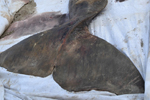A new study in the open access journal PLoS ONE estimates that manta rays are worth $140 million a year in tourism across 23 countries, significantly outweighing the worth of manta ray gill plates, which have become the newest craze in Traditional Chinese Medicine.
“As an example in Indonesia, revenue to fishermen from manta gill plates is estimated at roughly $400,000, while manta tourism brings in over $15 million in revenue to communities that can continue year after year without depleting manta populations,” says lead author Mary O’Malley in a press release.
In recent years, manta rays (comprising two species) have been targeted for their gill plates, which are increasingly believed to be medicinal in East Asia. But the new study finds that the gill plate trade in manta rays is worth only around $5 million a year, or about 3.5 percent of their worth as tourism species. As incredibly slow breeders, manta rays are particularly sensitive to overfishing.
“While the meat of these animals is deemed to be of poor quality and is worth little the gill plates or branchial filaments have become highly sought after in Asian markets where they are utilized in a tonic marketed to treat a wide variety of conditions,” the researchers write. The plates are purported to cure all sorts of diseases from asthma to chicken pox to cancer. However, the Manta Trust notes on its website that there is no evidence that the gills are medicinal.
“Some practitioners even [admit] that gill plates are not effective and that many other alternatives are available,” according to the NGO, which is devoted to protecting the marine animals.
This March both manta ray species—the giant manta ray (Manta birostris) and the reef manta ray (Manta alfredi)—won new protections from the CITES (the Convention on International Trade in Endangered Species). Listed under Appendix II, the manta rays won tougher regulations but not an outright ban.
Manta rays are not the only ones imperiled by the gill plate trade: mobula rays, which includes nine distinct species, are also targeted. The trade in mobula rays gill plates is estimated at $6.3 million. Mobula rays are not protected by CITES.

A reef manta ray and dive tourist in Raja Ampat, Indonesia. Photo by: Mary O’Malley.
CITATION: O’Malley MP, Lee-Brooks K, Medd HB (2013) The Global Economic Impact of Manta Ray Watching Tourism. PLoS ONE 8(5): e65051. doi:10.1371/journal.pone.0065051
Related articles
Sharks and rays win protections at CITES

(03/11/2013) Today, for the first time, sharks and rays have won the vote for better protection under CITES (the Convention on International Trade in Endangered Species), the world’s regulating body on trade in threatened species. Five shark species and manta rays, which includes two species, have received enough votes to be listed under Appendix II of CITES, which means tougher regulations, but not an outright ban. However, the votes could still be overturned before the end of the meeting.
Industrialized fishing has forced seabirds to change what they eat

(05/14/2013) The bleached bones of seabirds are telling us a new story about the far-reaching impacts of industrial fisheries on today’s oceans. Looking at the isotopes of 250 bones from Hawaiian petrels (Pterodroma sandwichensis), scientists have been able to reconstruct the birds’ diets over the last 3,000 years. They found an unmistakable shift from big prey to small prey around 100 years ago, just when large, modern fisheries started scooping up fish at never before seen rates. The dietary shift shows that modern fisheries upended predator and prey relationships even in the ocean ocean and have possibly played a role in the decline of some seabirds.
Scientists discover that marine animals disperse seagrass
(05/09/2013) Lesser known than coral reefs, marine seagrass ecosystems are rich in biodiversity and are powerhouses when it comes to sequestering carbon dioxide. Yet, much remains unknown about the ecology of seagrass beds, including detailed information on how seagrass spread their seeds and colonize new area. Now a recent study in Marine Ecology Progress Series documents that several species of marine animal are key to dispersing seagrass, overturning the assumption that seagrass was largely dispersed by abiotic methods (such as wind and waves).
Featured video: saving sea turtles in Mexico’s Magdalena Bay
(05/09/2013) A new short film, Viva la tortuga documents the struggle to save loggerhead and green sea turtles in Magdalena Bay, Mexico. Once a region for a massive sea turtle meat market, the turtles now face a new threat: bycatch. Loggerhead sea turtles are drowning in bottom-set gillnets, unable to escape from the nets once entangled. The issue has even raises threats of trade embargoes from the U.S.
Munching on marine plastic kills sperm whale

(05/07/2013) What do children’s toys, balloons, mattresses and plastic bags have in common? They can, along with more non-biodegradable pollutants, be found in the belly of a sperm whale, the topic of a new study in the Marine Pollution Bulletin. The same whale that swallowed Jonah from the Bible, Geppetto from Collodi’s Pinocchio, and the crew of the Pequod from Melville’s Moby-Dick is now swallowing trash from the Spanish-Mediterranean coast, and in the Strait of Gibraltar.